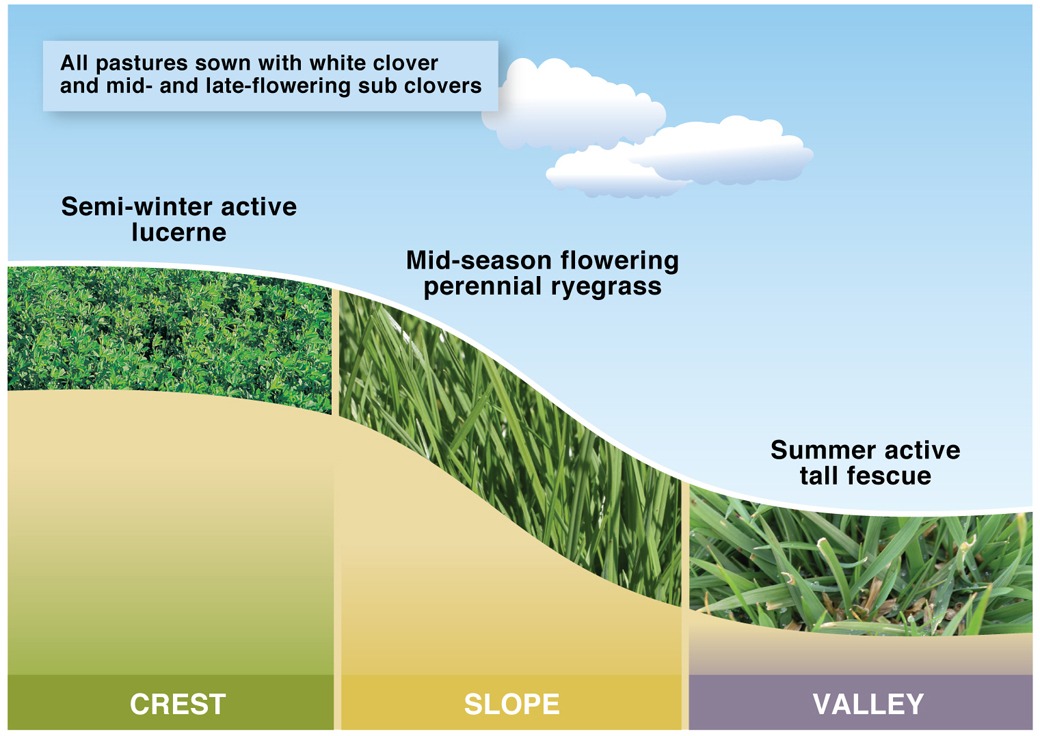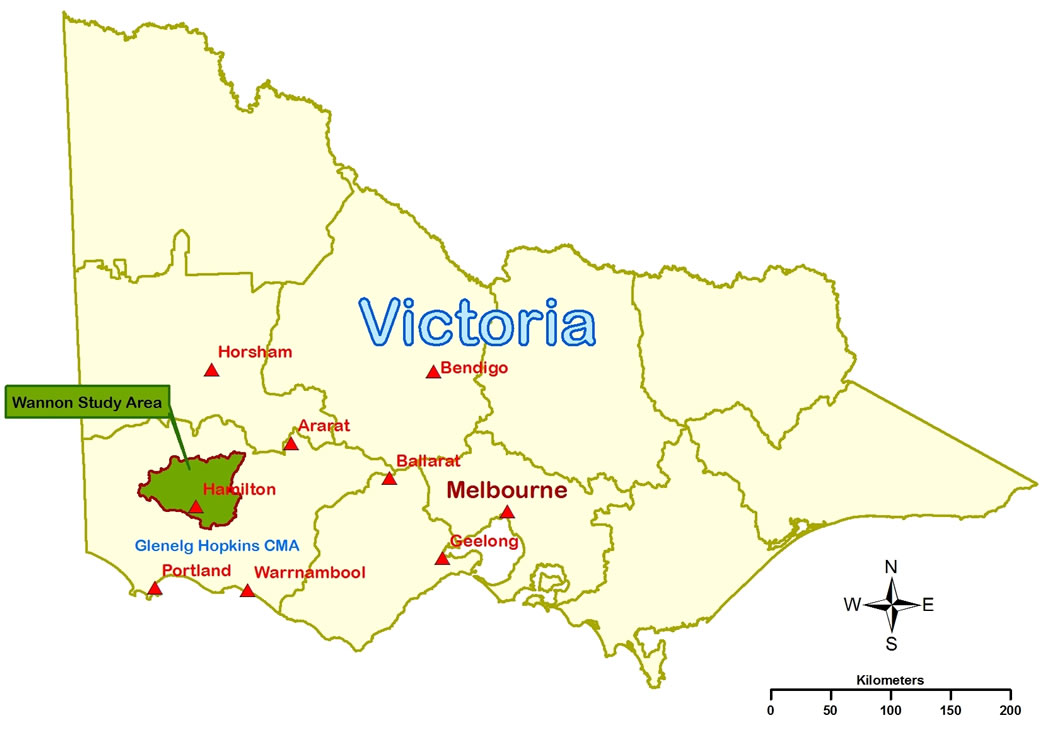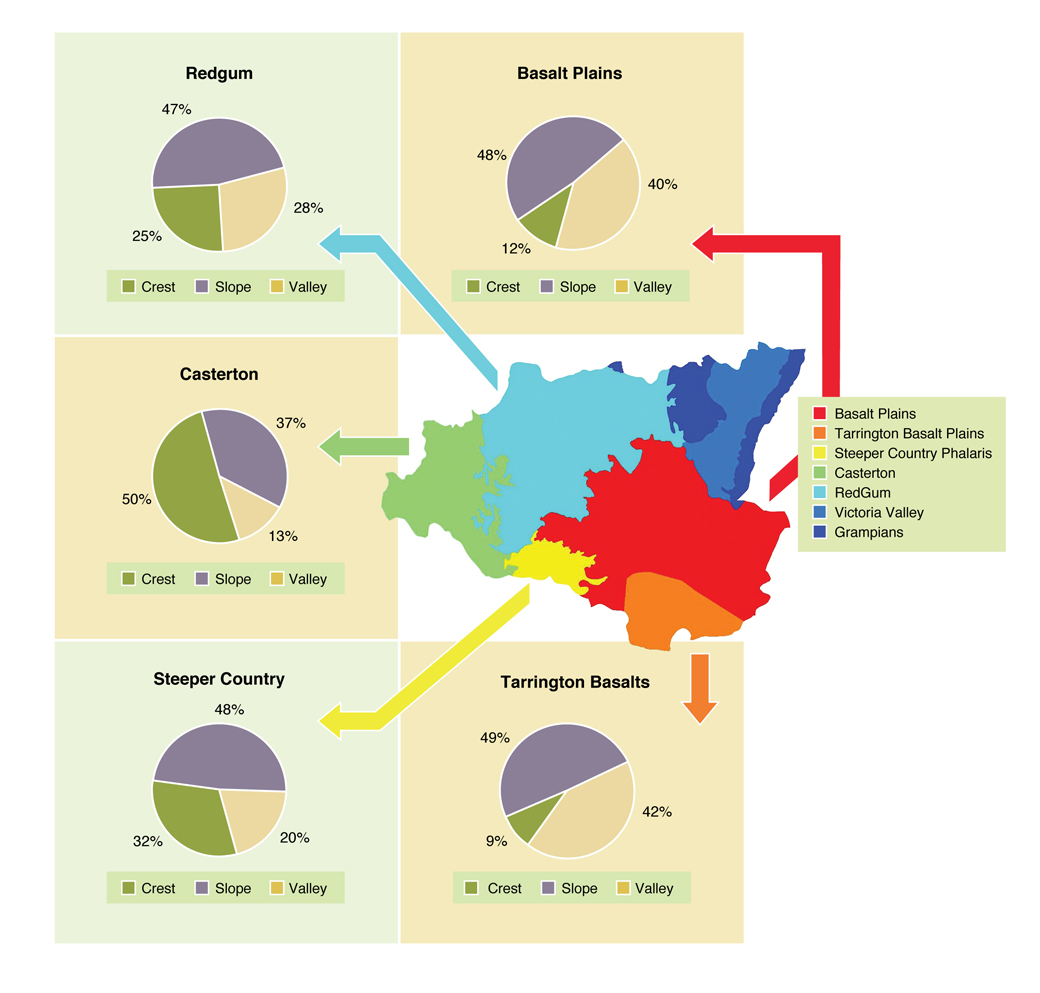Wannon Catchment Recharge Modelling
EverGraze Hamilton trialled pasture systems, based on perennials including perennial ryegrass, lucerne, tall fescue, chicory and kikuyu matched to landscape to extend the growing season and increase profit from livestock production while reducing groundwater recharge. Full details of the experiment can be found on the Hamilton Systems Experiment page. In summary, the pasture systems were:
- Perennial Ryegrass System; early flowering ryegrass (cv. Fitzroy) on the crest, mid flowering ryegrass (Avalon) on the slopes and late season ryegrass (cv. Banquet) on the valley floors.
- Triple System; where perennial ryegrass was replaced with semi winter active lucerne (cv. SARDI Seven), on the crests and summer active tall fescue (cv. Quantum) on the valley floors.
- Novel System; Chicory (cv. Grasslands Puna) was used on the crests, Italian (2006, 2007)/late finishing perennial ryegrass (cv. Banquet) (2008) ryegrass on the slopes and kikuyu (cv. Whittet) on the valley floors.
All pastures were sown or oversown with a mix of subterranean clovers (cv. Leura and Gosse) and white clover (cv. Mink).
Of the three systems, the Triple system (Figure 1) was found to have the highest potential for recharge control, and was therefore modelled to determine the potential impact of adoption of this system in the Wannon catchment.

- Figure 1 EverGraze Triple system
Applying the Triple system to the Wannon catchment
The Wannon catchment (Figure 2) located in south west Victoria was chosen for the study area. In order to apply the model to the whole catchment, the Triple system needed to be modified as the lower rainfall parts of the Wannon catchment are unsuitable for growing both tall fescue and perennial ryegrass due to persistence problems. The landscape was therefore grouped and appropriate species allocated to each of the crest, slope and valley floor in each grouping (Table 1). The percentage of area defined as crest, slopes and valleys is presented in Figure 3.

- Figure 2 Location of the Wannon catchment in Victoria.
Table 1 Adaptation of the Triple system species for each landform and landscape grouping in the Wannon catchment
| Landscape grouping | Crest | Slope | Valley |
| Basalt Plains | Lucerne | Perennial rye | Tall fescue |
| Tarrington Basalts | Lucerne | Perennial rye | Tall fescue |
| Steeper Country | Lucerne | Phalaris | Phalaris |
| Casterton 1 | Lucerne | Phalaris | Phalaris |
| Casterton 2 | Phalaris | Phalaris | Lucerne |
| Redgum | Lucerne | Phalaris | Phalaris |

- Figure 3 Percentage of crest, slopes and valleys in each land grouping
For each land grouping zone a range of different scenarios were tested to determine modelled recharge response from adoption of the Triple system. Recharge is reported for each scenario as a mean annual recharge between 1957 and 2008. Therefore, adoption of a system attempted to take into account the area of that system available. This is especially important for the Basalt Plains as 50% of the land area was from the “Slope” land class which was planted to perennial ryegrass which has a very similar water use pattern to annual ryegrass. Within the EverGraze Triple Pasture System, lucerne has the highest potential to use water and control recharge but it is also the most restricted in its adaptability to different land classes due to its sensitivity to poor drainage and waterlogging. For this reason, the results are based on land use and generally based on pasture systems with a low percentage of lucerne.
To allow a comparison of recharge control for various land-use scenarios in the Wannon catchment, including current practice, the following results are presented relative to the best and worst results possible within the different catchment areas. The best and worst results that could be achieved within the catchment by land-use change are shown as red bars. Hypothetical, maximum possible upper bound (largest increase in recharge) would occur if presently cleared land were fully replaced by annual grasses (Annual 100). The hypothetical maximum possible lower bound (largest decrease in recharge) would occur if all land was fully replaced by tree plantations (Tree 100). Various adoption scenarios for the EverGraze Triple system decrease recharge. The difference between the lower bound (Tree 100) and upper bound represents the hydrologic manoeuvring capability (“size of the bucket”) for the perenniality variation within the catchment, based on the past 57 years of climatic record. An additional reference point of a hypothetical farm containing 25% Lucerne was also presented. These hypothetical reference points would not be possible over the entire Wannon landscape and are meant to represent consistent point of comparison to the various land-use scenario.
Further information on the results can be found on the Key Message page Adoption of EverGraze Triple System will reduce recharge in the Wannon Catchment

